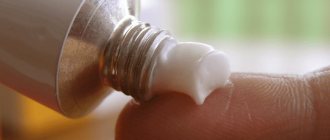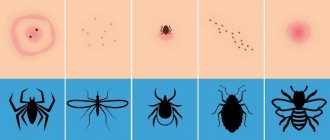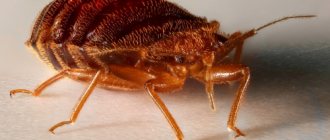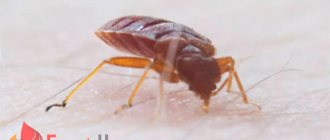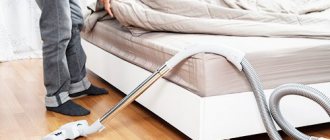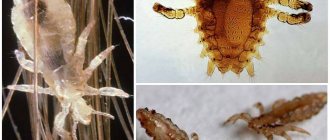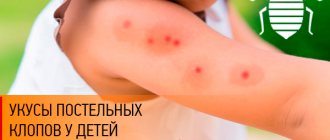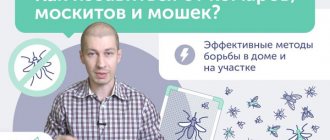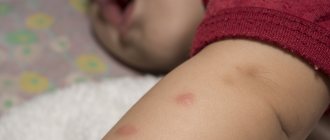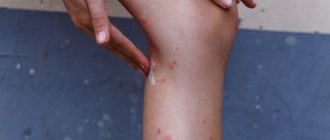Bedbugs are insects that have high vitality. They are able to go without food for months, falling into suspended animation, and also often “travel” to find new sources of food for themselves. Interestingly, bedbug bites are often mistaken for other skin lesions. Most often, they are mistaken for mosquito or flea bites, and sometimes for allergic dermatitis. Photos of bites, as well as their description, will help to correctly interpret skin lesions. The bedbug is a parasite that many have only seen in photographs. However, recently there has been a widespread spread of bedbugs, and parasites are found not only in old barracks, but also in recently occupied new buildings. The reason for the spread of bedbugs is the ability of these insects to adapt well to various conditions. And also the fact that many people who have not encountered these parasites before do not know how to understand that bedbugs have appeared in the house. And periodically appearing bites are mistaken for skin diseases.
What do the bites look like?
A specialist entomologist can easily recognize bedbug bites and distinguish them from the bites of other blood-sucking insects. But those people who have not encountered these domestic parasites before often mistake bedbug bites for other skin lesions. Meanwhile, it wouldn’t hurt anyone to see what bedbug bites look like so that they can take timely action if necessary. Naturally, it is better to see bites in a photo rather than on your own body. So, a bug bite usually looks like mosquito bites that everyone is familiar with. However, it is more painful and has clearer boundaries. As you can see in the photo of the bites, the damage looks like a swelling with a dense lump at the site of the skin puncture. The main differences between bedbug bites and the consequences of “close contact” with other blood-sucking insects are: • Location in groups; • Plurality. The fact is that domestic bugs multiply extremely quickly, so insects live in large numbers in an infested room. Domestic bedbugs do not have a clearly organized structure, but they live in large groups (clusters of bedbugs are usually called nests). As you can see in the photo, bedbug bites are located in groups, so-called “paths”. The fact is that the insect, in order to get enough, makes a series of bites, moving along the body of the victim. It is these “paths” of bites that are one of the main signs of the presence of bedbugs in the house.
Individual reactions
Essentially, bite marks are the body's immune response to the presence of foreign substances in the body. Such a foreign substance is the secretion (saliva) of a domestic bug, which the insect injects at the time of the bite. Advice! By piercing the skin, the bug injects a special secretion into the wound. This secretion contains anesthetic substances that allow the bug to drink its blood unnoticed by the victim. And also, substances that thin the blood, making it easier for the bug to feed. • If the reaction to the secretion of bedbugs is weak, a small red spot remains at the site of the bite. Insensitive people often do not notice bites, and for a long time do not realize the presence of bedbugs in the premises. • A moderate reaction to bites is typical for most people. They develop a small swelling at the site of the wound with a thickening in the center. • If the reaction is severe, large lumps form at the site of the bites. In the most severe cases, general symptoms may develop - the formation of edema, the appearance of a rash, etc. How strong the reaction to a bug bite can be can be seen in the photos posted on thematic sites. Advice! Most often, men are less sensitive to bedbug bites than children and women.
Why allergies occur
When an insect bites, substances that prevent blood clotting enter the human bloodstream along with saliva.
In response to their entry, the human immune system provokes the production of response substances - histamines, which provoke a corresponding response.
The result of these processes is the appearance of redness and swelling in the bite area, and the development of inflammatory processes.
Important! Negative reactions from the body that develop against the background of allergens, which are substances produced by bedbugs, may not occur in every person.
Most people do not notice any symptoms even after being bitten by bedbugs.
How to treat?
For moderate and mild reactions to bedbug bites, special treatment is not necessary. The main thing is to prevent scratching. Therefore, if severe itching is felt at the site of the bites, you can use various means to reduce its intensity. From pharmaceutical products you can use: • Fenistil gel; • “Psilo-balm”; • Balm “Golden Star”. You can also use folk remedies to relieve itching: • Cold can be applied to the bite sites; • Treat the skin with tincture of St. John's wort or propolis; • Wash the bite areas with a soda solution. Advice! Severe allergic reactions require antihistamines, and in severe cases, emergency medical attention may be required.
Bedbug bites: advantages and disadvantages of folk remedies for treatment
How to treat bed bug bites? Folk remedies
Despite the rapid development of medicine and the regular emergence of new pharmaceuticals, folk remedies remain still relevant. Many of us use our grandparents' methods to treat bed bug bites without resorting to special ointments, gels or creams.
The main and undeniable advantage of folk remedies is their naturalness. If you look at the composition of the ointment, you will probably find complex and unfamiliar words in it; if you use folk remedies, all the ingredients will be known and familiar to you. Folk remedies are considered safer and less likely to cause allergies.
Another important advantage of folk remedies is that they are usually cheaper than store-bought drugs. In addition, they can be made from scrap items found in any home. This advantage will be especially relevant if you are bitten by a bedbug somewhere in nature, when it is not possible to get to the pharmacy.
But folk remedies also have their drawbacks. First, you need to take the time to find a recipe and prepare a remedy to treat bed bug bites. Secondly, traditional methods are less effective compared to special drugs: they are absorbed faster and have only a short-term effect.
What to do if you find bedbug bites?
If you see swellings on your skin or someone in your household that hurt and itch, you should suspect that the room is infested with bedbugs. To make sure of this, you need to: • Inspect the bed linen. You will notice small droplets of blood on the sheets, as well as strange dark-colored specks. These specks are insect excrement; you can see how it looks on linen in the photo. • Inspect the mattress. In the seams of a mattress or the folds of sofas you can see empty chitinous shells (they are shed by larvae) and a large amount of excrement. It is often possible to find a nest of insects in the bed. As can be seen in the photo, in such a cluster you can see adult insects, larvae of different ages, eggs, empty chitinous shells and excrement. • Since bedbugs come out of their hiding places mainly at night, you can do this simple test: get up at 3-4 am and turn on the lights sharply, throwing back the blanket. On the sheet you can see parasites scattering in different directions. • If the premises are heavily infested, bedbugs can be found not only in the bedroom furniture, but throughout the apartment. These parasites often live in crevices around baseboards, door frames and under window sills. Accumulations of bedbugs can be found on the back walls of furniture and in its cracks and grooves (for example, in the grooves of drawers).
How to deal with bedbugs?
Once you are sure that bedbugs have settled in the house, you will need to take measures to completely exterminate them. As you can see in the photo, the bug has a flat body protected by a chitinous shell. Therefore, this insect is difficult to crush. In addition, bedbugs run quickly and immediately hide in shelters. Therefore, the mechanical method of controlling bedbugs is ineffective. However, it can be used as an auxiliary one. For example, if you find a bedbug nest, you can remove it with a vacuum cleaner. A fairly effective method is the temperature method of killing bedbugs. If possible, contaminated items can be treated using a steam generator or taken out into the cold. But since total treatment of an apartment cannot be carried out using this method, it is used as an auxiliary one. The most reliable way to exterminate bedbugs is to use modern insecticides. The treatment can be carried out independently, using products approved for household use. In case of severe infection, it is better to contact a professional.
Does baking soda help against bedbugs?
Soda kills bedbugs, but only when you need to kill 1-2 bedbugs in isolated conditions. Even with a small infection, in a single piece of furniture, it is not effective.
If you put the bug in an airtight jar and pour a few spoons of soda powder into it, after 2-3 days it will die, completely dry. Flour, sugar, salt and other substances that absorb moisture will have a similar effect.
Insects die a little faster when exposed directly to soda slaked with boiling water (up to 15 minutes). We conducted such an experiment. To find out how it ended, watch this video.
Sodium bicarbonate is an inorganic substance and therefore does not act as a chemical poison. It absorbs moisture, but very weakly, and is not on the list of drying agents.
Therefore, it is at least unreasonable to perceive soda as an effective means for killing bedbugs.
conclusions
So, having familiarized yourself with the photos and descriptions of bedbug bites in advance, you will be able to promptly detect the appearance of parasites in the house.
After all, the sooner disinfestation was carried out after the infection, the easier it will be to completely get rid of parasites in the house. You can buy all the necessary products to combat insects and pests on our website . For any questions, you can always call us at 8 (800) 775-81-02 and consult on the product you are interested in . We are always happy to assist in resolving issues related to the fight against insects and rodents .
Treatment
It is important to know what to do if you are bitten by bedbugs in order to minimize the risk of developing an allergic reaction and prevent possible negative health consequences.
Therapy against allergic reactions is based on the use of antiallergic drugs and the involvement of the elimination complex. It is important to select medications only after consulting a doctor.
Antiallergic therapy
Therapy for bedbugs and the development of allergies includes taking antihistamines. Additionally, medications can be used to help remove toxins from the body and improve overall well-being.
Popular medications that are most often used for bedbug allergies are:
- Zyrtec.
- Claritin.
- Erius.
- Eden.
- Telfast.
- Pulmicort.
- Advanta.
To eliminate skin and other manifestations of a negative reaction from the body, the patient may be prescribed medications that have anti-edematous, anti-inflammatory, and analgesic properties.
It is not recommended to select any drug on your own, as this may cause the condition to worsen.
Elimination complex
An allergy to bedbugs occurs due to exposure of the body to substances that are part of biological fluids and waste products of bedbugs.
This pathology should be treated with medications and methods that include the elimination of potential allergens.
The elimination complex implies the mandatory implementation of events of this kind:
- It is necessary to boil or wash underwear, bed linen, and home textiles in hot water. After washing, it is advisable to freeze the items in the cold for three to five hours.
- It is recommended to remove old wallpaper and fill the cracks in the walls with silicone or another substance.
- It is important to treat all furniture, especially sofas and beds, since this is where the maximum number of parasites are most often localized and their nests are located. To remove blood-sucking insects, you need to cover the furniture with insecticides, steam, or lay out dry branches of wormwood and tansy.
- After treatment, it is recommended to take measures to help prevent the reappearance of parasites in the house. It is important to regularly carry out wet and dry cleaning, preferably with a vacuum cleaner. It is recommended to carry things in closets and bags that are hermetically sealed.
The above measures are effective only if the premises are slightly infested with bedbugs.
Against the backdrop of severe infestation, it is recommended to treat the premises with insecticidal preparations or seek help from a professional service.
Video
Allergy to insect bites, what to do?
If you are bitten by bedbugs
Trust the professionals and contact the Moscow Sanitary and Epidemiological Station. We will quickly and safely rid you of unwanted guests and return restful sleep to your home.
Review
Our long-awaited event was marred by the presence of unwanted guests. We purchased an apartment in a residential area. The previous owners rewarded us with a bonus - they kept their old sofa. As it turned out later, there were bedbugs in the mattress. The wife and children were shocked and flatly refused to move into the purchased apartment. I had to solve the problem radically. The gift was thrown into a landfill, and the entire apartment was treated by the guys from GorSES. The drug turned out to be effective and a week later, after general cleaning, we moved in. Traces of bedbugs no longer appear on the body. Thank you very much!
Soda in folk remedies
Let's look at a couple of folk recipes for killing bedbugs, in which a soda solution is combined with other substances.
Recipe 1.
Dissolve 150 grams of soda in 1 liter of hot water and mix thoroughly. Pour 100 ml of turpentine and 150 ml of kerosene into the mixture and leave for 60 minutes. Before use, add 35 ml of liquid soap.
This recipe is categorically unacceptable for allergy sufferers and, in general, is quite radical - the point is a strong and corrosive odor after treatment, which cannot be quickly aired out or washed off.
Recipe 2.
Dissolve 30 grams of naphthalene in 100 ml of turpentine, add 100 grams of soda, stir until a homogeneous mass is formed and pour in a liter of water. Let it brew for 2 hours.
The solution is applied with special care to folds, joints and seams of furniture, cracks and crevices.
You need to repeat the treatment every week, the effect will appear gradually. Getting rid of bedbugs in this way will most likely take more than one month, which depends on the initial number of insects.
Are bedbugs afraid of soda or are they attracted to it?
Soda does not have a repellent effect. It's just the opposite. Theoretically, it can serve as a bait for bedbugs.
When interacting with vinegar (or boiling water), baking soda releases carbon dioxide, which triggers the bedbugs to search for food and draws them to the area within which the bait is localized.
However, it is not so easy for bedbugs to confuse the cards. Don’t forget - warmth, smell and many other signals from our body are no less significant for bloodsuckers.
Pronounced symptoms after bedbug bites
Typical symptoms after a pest attack:
- itching and burning in the affected areas of the body;
- swelling in bitten areas;
- general weakness;
- in some cases - an increase in temperature.
Scratching the bite site increases the risk of introducing infection into the body. If this happens, a deterioration in well-being and the development of depression are added to the general symptoms. Especially impressionable people often become over-irritable and fearful when they see photos of bedbug bites. This leads to the development of insomnia. A person simply cannot sleep at night, fearing that insects will bite him. As a result, performance is significantly reduced during the daytime.
It is possible to get rid of bed bugs at home, but not always!
Bed bugs are dangerous insects. They multiply quickly. Therefore, it is not easy to get rid of them. Bed bugs often hide in clothes, bedding, chairs, and mattresses. In order to reproduce and maintain their life cycle, they feed on the blood of animals and humans.
